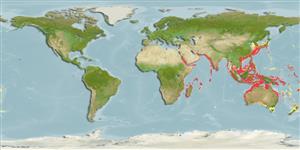Common names from other countries
Classification / Names / Names
Nomes comuns | Sinônimos | Catalog of Fishes (gen., sp.) | ITIS | CoL | WoRMS
Environment: milieu / climate zone / depth range / distribution range
Ecologia
; intervalo de profundidade 60 - 399 m (Ref. 78901), usually 60 - 200 m (Ref. 76930). Tropical
Indo-West Pacific: Red Sea to Japan, Philippines and Indonesia. Pérez Farfante (Ref. 75620) recognizes 3 subspecies: Parapenaeus fissuroides fissuroides from Indonesia to Japan and the Philippines, Parapenaeus fissuroides erythraeus from the Red Sea and Parapenaeus fissuroides indicus from east Africa and Madagascar.
Length at first maturity / Tamanho / Peso / Idade
Maturity: Lm ? range ? - ? cm Max length : 2.7 cm CL macho/indeterminado; (Ref. 119007); 3.61 cm CL (female)
Found in high salinity and high temperature areas (Ref. 76930).
Life cycle and mating behavior
Maturidade | Reprodução | Desova | Ovos | Fecundidade | Larvas
Members of the order Decapoda are mostly gonochoric. Mating behavior: Precopulatory courtship ritual is common (through olfactory and tactile cues); usually indirect sperm transfer.
Pérez Farfante, I. and B. Kensley. 1997. (Ref. 75620)
Status na Lista Vermelha da IUCN (Ref. 130435)
Status no CITES (Ref. 108899)
Not Evaluated
Not Evaluated
Uso pelos humanos
| FishSource |
Ferramentas
Fontes da internet
Estimates based on models
Resiliência
Elevada, tempo mínimo de duplicação da população menor que 15 meses (K=0.94-1.01; tm=1).
